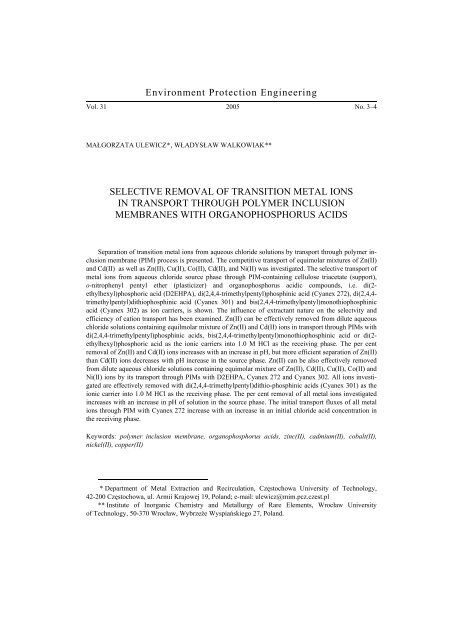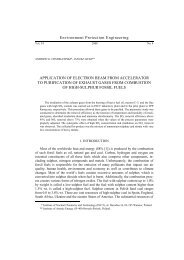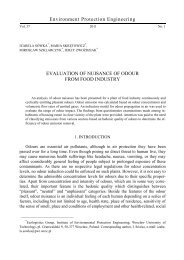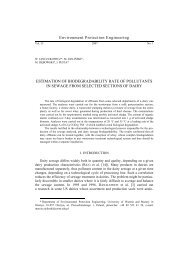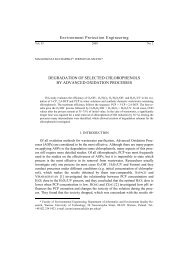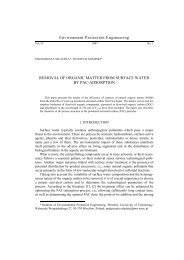Selective removal of transition metal ions in transport - EPE ...
Selective removal of transition metal ions in transport - EPE ...
Selective removal of transition metal ions in transport - EPE ...
You also want an ePaper? Increase the reach of your titles
YUMPU automatically turns print PDFs into web optimized ePapers that Google loves.
Environment Protection Eng<strong>in</strong>eer<strong>in</strong>g<br />
Vol. 31 2005 No. 3–4<br />
MAŁGORZATA ULEWICZ*, WŁADYSŁAW WALKOWIAK**<br />
SELECTIVE REMOVAL OF TRANSITION METAL IONS<br />
IN TRANSPORT THROUGH POLYMER INCLUSION<br />
MEMBRANES WITH ORGANOPHOSPHORUS ACIDS<br />
Separation <strong>of</strong> <strong>transition</strong> <strong>metal</strong> <strong>ions</strong> from aqueous chloride solut<strong>ions</strong> by <strong>transport</strong> through polymer <strong>in</strong>clusion<br />
membrane (PIM) process is presented. The competitive <strong>transport</strong> <strong>of</strong> equimolar mixtures <strong>of</strong> Zn(II)<br />
and Cd(II) as well as Zn(II), Cu(II), Co(II), Cd(II), and Ni(II) was <strong>in</strong>vestigated. The selective <strong>transport</strong> <strong>of</strong><br />
<strong>metal</strong> <strong>ions</strong> from aqueous chloride source phase through PIM-conta<strong>in</strong><strong>in</strong>g cellulose triacetate (support),<br />
o-nitrophenyl pentyl ether (plasticizer) and organophosphorus acidic compounds, i.e. di(2ethylhexyl)phosphoric<br />
acid (D2EHPA), di(2,4,4-trimethylpentyl)phosph<strong>in</strong>ic acid (Cyanex 272), di(2,4,4trimethylpentyl)dithiophosph<strong>in</strong>ic<br />
acid (Cyanex 301) and bis(2,4,4-trimethylpentyl)monothiophosph<strong>in</strong>ic<br />
acid (Cyanex 302) as ion carriers, is shown. The <strong>in</strong>fluence <strong>of</strong> extractant nature on the selectvity and<br />
efficiency <strong>of</strong> cation <strong>transport</strong> has been exam<strong>in</strong>ed. Zn(II) can be effectively removed from dilute aqueous<br />
chloride solut<strong>ions</strong> conta<strong>in</strong><strong>in</strong>g equilmolar mixture <strong>of</strong> Zn(II) and Cd(II) <strong>ions</strong> <strong>in</strong> <strong>transport</strong> through PIMs with<br />
di(2,4,4-trimethylpentyl)phosph<strong>in</strong>ic acids, bis(2,4,4-trimethylpentyl)monothiophosph<strong>in</strong>ic acid or di(2ethylhexyl)phosphoric<br />
acid as the ionic carriers <strong>in</strong>to 1.0 M HCl as the receiv<strong>in</strong>g phase. The per cent<br />
<strong>removal</strong> <strong>of</strong> Zn(II) and Cd(II) <strong>ions</strong> <strong>in</strong>creases with an <strong>in</strong>crease <strong>in</strong> pH, but more efficient separation <strong>of</strong> Zn(II)<br />
than Cd(II) <strong>ions</strong> decreases with pH <strong>in</strong>crease <strong>in</strong> the source phase. Zn(II) can be also effectively removed<br />
from dilute aqueous chloride solut<strong>ions</strong> conta<strong>in</strong><strong>in</strong>g equimolar mixture <strong>of</strong> Zn(II), Cd(II), Cu(II), Co(II) and<br />
Ni(II) <strong>ions</strong> by its <strong>transport</strong> through PIMs with D2EHPA, Cyanex 272 and Cyanex 302. All <strong>ions</strong> <strong>in</strong>vestigated<br />
are effectively removed with di(2,4,4-trimethylpentyl)dithio-phosph<strong>in</strong>ic acids (Cyanex 301) as the<br />
ionic carrier <strong>in</strong>to 1.0 M HCl as the receiv<strong>in</strong>g phase. The per cent <strong>removal</strong> <strong>of</strong> all <strong>metal</strong> <strong>ions</strong> <strong>in</strong>vestigated<br />
<strong>in</strong>creases with an <strong>in</strong>crease <strong>in</strong> pH <strong>of</strong> solution <strong>in</strong> the source phase. The <strong>in</strong>itial <strong>transport</strong> fluxes <strong>of</strong> all <strong>metal</strong><br />
<strong>ions</strong> through PIM with Cyanex 272 <strong>in</strong>crease with an <strong>in</strong>crease <strong>in</strong> an <strong>in</strong>itial chloride acid concentration <strong>in</strong><br />
the receiv<strong>in</strong>g phase.<br />
Keywords: polymer <strong>in</strong>clusion membrane, organophosphorus acids, z<strong>in</strong>c(II), cadmium(II), cobalt(II),<br />
nickel(II), copper(II)<br />
* Department <strong>of</strong> Metal Extraction and Recirculation, Częstochowa University <strong>of</strong> Technology,<br />
42-200 Częstochowa, ul. Armii Krajowej 19, Poland; e-mail: ulewicz@mim.pcz.czest.pl<br />
** Institute <strong>of</strong> Inorganic Chemistry and Metallurgy <strong>of</strong> Rare Elements, Wrocław University<br />
<strong>of</strong> Technology, 50-370 Wrocław, Wybrzeże Wyspiańskiego 27, Poland.
74<br />
M. ULEWICZ, W. WALKOWIAK<br />
1. INTRODUCTION<br />
<strong>Selective</strong> <strong>removal</strong> <strong>of</strong> <strong>metal</strong> <strong>ions</strong> from <strong>in</strong>dustrial and waste solut<strong>ions</strong> is frequently<br />
required <strong>in</strong> hydro<strong>metal</strong>lurgical process<strong>in</strong>g. In recent years, liquid membranes are<br />
commonly used for separation <strong>of</strong> <strong>metal</strong> <strong>ions</strong> from aqueous solut<strong>ions</strong> [1], [2]. The use<br />
<strong>of</strong> liquid membranes conta<strong>in</strong><strong>in</strong>g ion carriers <strong>of</strong>fers an alternative to solvent extraction<br />
<strong>in</strong> selective <strong>removal</strong> <strong>of</strong> <strong>metal</strong> <strong>ions</strong> from source aqueous phase and their concentration.<br />
In this case, the concentration <strong>of</strong> <strong>metal</strong> ionic species is above 1·10 –4 M.<br />
A variety <strong>of</strong> liquid membrane types is represented, among others, by bulk (BLM),<br />
emulsion (ELM), supported (SLM), and polymer <strong>in</strong>clusion membranes (PIM) [3], [4].<br />
The PIMs are formed by cast<strong>in</strong>g cellulose triacetate (CTA) from an organic solution to<br />
form a th<strong>in</strong> film. The cast<strong>in</strong>g solution also conta<strong>in</strong>s an ion exchange carrier and<br />
a membrane plasticizer.<br />
Solvent extraction us<strong>in</strong>g organophosphorus compounds such as di(2-ethyl-<br />
hexyl)phosphoric acid (D2EHPA), di(2,4,4-trimethylpentyl)-phosph<strong>in</strong>ic acid (Cyanex<br />
272), di(2,4,4-trimethylpentyl)dithiophosph<strong>in</strong>ic acid (Cyanex 301) and bis(2,4,4trimethylpentyl)monothiophosph<strong>in</strong>ic<br />
acid (Cyanex 302) has been widely used for selective<br />
recovery <strong>of</strong> heavy <strong>metal</strong> from acidic solut<strong>ions</strong> <strong>in</strong> hydro<strong>metal</strong>lurgical process.<br />
Accord<strong>in</strong>g to SOLE and HISKEY [5] the solvent extraction order for Cyanex 272 is as<br />
follows: Fe(III) < Zn(II) < Cu(II) < Co(II) < Ni(II); Cyanex 302: Cu(II) < Fe(III) <<br />
Zn(II) < Co(II) < Ni(II) and Cyanex 301: Cu(II) < Zn(II) < Fe(III) < Co(II) ≈ Ni(II).<br />
BINGHUA et al. [6] have established the follow<strong>in</strong>g solvent extraction order for<br />
D2EHPA: Fe(III) > Zn(II) > Mn(II) > Cd(II) > Cu(II) > Mg(II) > Co(II) > Ni(II).<br />
A liquid membrane conta<strong>in</strong><strong>in</strong>g specific ion carriers can be an alternative to the solvent<br />
extraction allow<strong>in</strong>g selective separation <strong>of</strong> <strong>metal</strong> <strong>ions</strong> from aqueous solut<strong>ions</strong> and<br />
their concentration. The separation <strong>of</strong> Co(II) and Ni(II) by supported and hybrid liquid<br />
membranes with D2EHPA, Cyanex 272, Cyanex 301, and Cyanex 302 was presented<br />
by WALKOWIAK et al. [7], [8]. The Co(II) and Ni(II) <strong>ions</strong> fluxes are <strong>in</strong>creased <strong>in</strong> the<br />
follow<strong>in</strong>g order <strong>of</strong> ion carriers: Cyanex 272 < Cyanex 302 < D2EHPA < Cyanex 301.<br />
Z<strong>in</strong>c(II) <strong>ions</strong> were effectively <strong>transport</strong>ed through the multimembrane hybrid system<br />
with D2EHPA [9] and through the supported liquid membrane with D2EHPA [10]. It<br />
was found that the ion carrier concentration has no effect on the <strong>transport</strong> <strong>of</strong> z<strong>in</strong>c <strong>ions</strong>,<br />
while temperature, pH <strong>of</strong> feed phase, flow rate <strong>of</strong> feed and stripp<strong>in</strong>g phases and the<br />
stripp<strong>in</strong>g concentration are important parameters <strong>of</strong> the <strong>transport</strong>. ULEWICZ et al. [12],<br />
[13] studied selective <strong>removal</strong> <strong>of</strong> z<strong>in</strong>c from chloride aqueous solut<strong>ions</strong> and its <strong>transport</strong><br />
across polymer <strong>in</strong>clusion membranes with D2EHPA [11], [12] and Cyanex 272<br />
[13]. Cadmium (II) <strong>ions</strong> were also effectively <strong>transport</strong>ed through polymer <strong>in</strong>clusion<br />
membrane (PIM) with Cyanex 923 [14]. Optimal experimental condit<strong>ions</strong> were obta<strong>in</strong>ed<br />
after 3 h us<strong>in</strong>g membrane conta<strong>in</strong><strong>in</strong>g 30% v/v Cyanex 923 dissolved <strong>in</strong> xylene<br />
and soaked <strong>in</strong> microporous Durapore GVHP support.<br />
Now we present the results <strong>of</strong> competitive <strong>transport</strong> <strong>of</strong> z<strong>in</strong>c(II) and cadmium(II) <strong>ions</strong>
<strong>Selective</strong> <strong>removal</strong> <strong>of</strong> <strong>transition</strong> <strong>metal</strong> <strong>ions</strong> 75<br />
through polymer <strong>in</strong>clusion membranes as well as the results <strong>of</strong> <strong>transport</strong> <strong>of</strong> <strong>transition</strong><br />
<strong>metal</strong> <strong>ions</strong> from equimolar mixture <strong>of</strong> all <strong>metal</strong> <strong>ions</strong> <strong>in</strong>vestigated, i.e. Zn(II), Cu(II),<br />
Co(II), Ni(II) and Cd(II) <strong>ions</strong> from dilute aqueous solut<strong>ions</strong> (cMe = 0.01 M). In both types<br />
<strong>of</strong> solut<strong>ions</strong>, the same <strong>metal</strong> ion carriers, i.e. di(2-ethylhexyl)phosphoric acid<br />
(D2EHPA), di(2,4,4-trimethylpentyl)phosph<strong>in</strong>ic acid (Cyanex 272), di(2,4,4-trimethyl-<br />
pentyl)dithiophosph<strong>in</strong>ic acid (Cyanex 301) and bis(2,4,4-trimethylpentyl)monothiopho-<br />
sph<strong>in</strong>ic acid (Cyanex 302), were used. The selectivity <strong>of</strong> <strong>metal</strong> <strong>ions</strong>’ separation with<br />
organophosphorus acidic compounds as a function <strong>of</strong> pH <strong>of</strong> aqueous solution and an<br />
<strong>in</strong>itial concentration <strong>of</strong> hydrochloric acid <strong>in</strong> the receiv<strong>in</strong>g phase is shown.<br />
2. EXPERIMENTAL<br />
Initial aqueous solut<strong>ions</strong> were prepared with redistilled water, hydrogen chloride<br />
and the follow<strong>in</strong>g salts: CdCl2, ZnCl2, CuCl2, CoCl2, NiCl2 (all from POCh, Gliwice,<br />
reagents <strong>of</strong> analytical grade). The organic chemicals, i.e. cellulose triacetate (Fluka),<br />
o-nitrophenyl pentyl ether (Fluka), and dichloromethane (POCh), were also <strong>of</strong> analytical<br />
reagent grade. The organophosphorus acidic compounds (Fluka) were: di(2ethylhexyl)phosphoric<br />
acid (D2EHPA), di(2,4,4-trimethylpentyl)phosph<strong>in</strong>ic acid<br />
(Cyanex 272), di(2,4,4-trimethylpentyl)dithiophosph<strong>in</strong>ic acid (Cyanex 301), and<br />
bis(2,4,4-trimethylpentyl)monothiophosph<strong>in</strong>ic acid, (Cyanex 302). The values <strong>of</strong> pKa<br />
were: 2.75 (D2EHPA), 6.37 (Cyanex 272), 2.61 (Cyanex 301), 5.63 (Cyanex 3020).<br />
The solut<strong>ions</strong> <strong>of</strong> cellulose triacetate (CTA) (as the support), organophosphorus<br />
acidic compounds (as the ion carrier), and o-nitrophenyl pentyl ether (ONPPE) (as the<br />
plasticizer) <strong>in</strong> dichloromethane were prepared. A portion <strong>of</strong> this organic solution was<br />
poured <strong>in</strong>to a membrane mould made <strong>of</strong> a glass r<strong>in</strong>g attached to a glass plate covered<br />
with cellulose triacetate-dichloromethane glue. Dichloromethane as an organic solvent<br />
was allowed to evaporate slowly overnight and the resultant polymer <strong>in</strong>clusion membrane<br />
was separated from the glass plate by immers<strong>in</strong>g it <strong>in</strong> water. The membrane was<br />
stored <strong>in</strong> water. The concentration <strong>of</strong> organophosphorus acidic compounds <strong>in</strong> membrane<br />
was 1.0 M <strong>in</strong> terms <strong>of</strong> plasticizer; 2.50 cm 3 <strong>of</strong> ONPPE / 1.0 g <strong>of</strong> CTA. Thickness<br />
<strong>of</strong> membranes was 35 μm. Freshly synthesized membranes were used <strong>in</strong> each<br />
experiment.<br />
Transport experiments were conducted <strong>in</strong> a permeation cell <strong>in</strong> which the membrane<br />
film (<strong>of</strong> the surface area <strong>of</strong> 4.9 cm 2 ) was tightly clamped between two cell compartments.<br />
Both solut<strong>ions</strong>, i.e. the source and receiv<strong>in</strong>g aqueous phases (45 cm 3<br />
each), were mechanically stirred at 600 rpm. The receiv<strong>in</strong>g phase was 0.01–1.0 M<br />
aqueous solution <strong>of</strong> hydrochloric acid. The source phases were aqueous solut<strong>ions</strong> conta<strong>in</strong><strong>in</strong>g<br />
Zn(II) and Cd(II) <strong>ions</strong> and the solution conta<strong>in</strong><strong>in</strong>g Zn(II), Cu(II), Co(II), Cd(II)<br />
and Ni(II) <strong>ions</strong>. The concentration <strong>of</strong> each ion <strong>in</strong> the solut<strong>ions</strong> was 0.01 M.<br />
The PIM <strong>transport</strong> experiments were carried out at the temperature <strong>of</strong> 20 ± 0.2 o C.
76<br />
M. ULEWICZ, W. WALKOWIAK<br />
Small samples (0.1 cm 3 each) <strong>of</strong> the aqueous receiv<strong>in</strong>g phase were removed periodically<br />
via a sampl<strong>in</strong>g port with a syr<strong>in</strong>ge and analyzed to determ<strong>in</strong>e z<strong>in</strong>c, copper, nickel,<br />
cobalt and cadmium concentrat<strong>ions</strong> by atomic absorption spectroscopy method.<br />
The acidity <strong>of</strong> source aqueous phase was controlled by pH-meter (pH meter, CX-731<br />
Elmetron, with comb<strong>in</strong>ed pH electrode, ERH-126, Hydromet, Poland) and kept constant<br />
by add<strong>in</strong>g periodically to each sample a small amount <strong>of</strong> 1.0 M aqueous solution<br />
<strong>of</strong> NaOH.<br />
The k<strong>in</strong>etics <strong>of</strong> <strong>metal</strong> ion <strong>transport</strong> through PIM was described by the first-order<br />
equation:<br />
⎛ c ⎞<br />
ln<br />
⎜ = −kt<br />
c ⎟ , (1)<br />
⎝ i ⎠<br />
were c is the <strong>metal</strong> ion concentration (M) <strong>in</strong> the source phase at some given time, ci is<br />
the <strong>in</strong>itial concentration <strong>of</strong> <strong>metal</strong> <strong>ions</strong> <strong>in</strong> the source phase, k is the rate constant (s –1 ),<br />
and t is the time <strong>of</strong> <strong>transport</strong> (s).<br />
In order to calculate k, the plots represent<strong>in</strong>g ln(c/ci) versus <strong>transport</strong> time were<br />
drawn. The rate constant value for the duplicate <strong>transport</strong> experiment was averaged<br />
and standard deviation calculated. The <strong>in</strong>itial flux (Ji) is def<strong>in</strong>ed by:<br />
V<br />
Ji = ⋅ k ⋅ ci<br />
, (2)<br />
A<br />
where V is the volume <strong>of</strong> the aqueous source phase, and A is the effective area <strong>of</strong> the<br />
membrane.<br />
The selectivity coefficient (S) was def<strong>in</strong>ed by the ratio <strong>of</strong> the <strong>in</strong>itial fluxes <strong>of</strong> M1<br />
and M2 <strong>metal</strong> <strong>ions</strong>, respectively:<br />
S = J<br />
J<br />
i,<br />
M1<br />
/ i,<br />
M 2<br />
. (3)<br />
The per cent <strong>removal</strong> (R) <strong>in</strong> PIM <strong>transport</strong> <strong>of</strong> <strong>metal</strong> <strong>ions</strong> from the source phase <strong>in</strong>to<br />
receiv<strong>in</strong>g phase was calculated as follows:<br />
ci<br />
− c<br />
R = ⋅100%<br />
. (4)<br />
c<br />
i<br />
3. RESULTS AND DISCUSSION<br />
The paper deals with a competitive <strong>transport</strong> <strong>of</strong> <strong>metal</strong> <strong>ions</strong> through polymer <strong>in</strong>clusion<br />
membranes conta<strong>in</strong><strong>in</strong>g 1.0 M organophosphorus acidic compounds as an ion carrier, i.e.<br />
di(2-ethylhexyl)phosphoric acid (D2EHPA), di(2,4,4-trimethylpentyl)phos-<br />
ph<strong>in</strong>ic acid (Cyanex 272), di(2,4,4-trimethylpentyl)dithiophosph<strong>in</strong>ic acid (Cyanex 301),
<strong>Selective</strong> <strong>removal</strong> <strong>of</strong> <strong>transition</strong> <strong>metal</strong> <strong>ions</strong> 77<br />
and bis(2,4,4-trimethylpentyl)monothiophosph<strong>in</strong>ic acid (Cyanex 302). Dur<strong>in</strong>g this <strong>transport</strong><br />
the <strong>ions</strong> are transferred from aqueous source phase (cMe = 0.01 M) to receiv<strong>in</strong>g<br />
aqueous phase. The k<strong>in</strong>etic parameters and selectivity orders <strong>of</strong> Zn(II) and Cd(II) <strong>ions</strong><br />
<strong>transport</strong>ed through PIM are shown <strong>in</strong> figure 1. The <strong>in</strong>itial fluxes <strong>of</strong> Zn(II) and Cd(II)<br />
cat<strong>ions</strong> <strong>in</strong>crease with an <strong>in</strong>crease <strong>in</strong> pH <strong>of</strong> the feed phase. Comparison <strong>of</strong> the ion fluxes<br />
through PIM shows that Zn(II) cat<strong>ions</strong> are <strong>transport</strong>ed much faster than Cd(II) <strong>ions</strong> with<br />
Cyanex 272 and D2EHPA as ion carriers. When Cyanex 301 is a carrier, the difference<br />
<strong>in</strong> the values <strong>of</strong> fluxes is not great. On the other hand, if Cyanex 302 is used as ion carrier,<br />
Cd(II) cat<strong>ions</strong> are <strong>transport</strong>ed faster than Zn(II) cat<strong>ions</strong>. The values <strong>of</strong> selectivity<br />
coefficients <strong>of</strong> Zn(II)/Cd(II) for D2EHPA, Cyanex 272 and Cyanex 301 decrease with an<br />
<strong>in</strong>crease <strong>in</strong> pH values. Also the values <strong>of</strong> selectivity coefficients <strong>of</strong> Cd(II)/Zn(II) for<br />
Cyanex 302 decrease with an <strong>in</strong>crease <strong>in</strong> pH values. The values <strong>of</strong> selectivity coefficients<br />
<strong>of</strong> Zn(II)/Cd(II) for <strong>transport</strong> with D2EHPA at pH 2.0, 3.0, 4.0 and 5.0 were 10.7,<br />
6.0, 5.4, and 5.0, respectively, whereas for the <strong>transport</strong> with Cyanex 301 they were 2.4,<br />
1.3, 1.2, 1.1, respectively. The values <strong>of</strong> selectivity coefficients <strong>of</strong> Zn(II)/Cd(II) for<br />
<strong>transport</strong> with Cyanex 272 at pH 3.0, 4.0 and 5.0 were 11.5, 8.4, and 7.9, respectively.<br />
The values <strong>of</strong> selectivity coefficients <strong>of</strong> Cd(II)/Zn(II) for <strong>transport</strong> with Cyanex 302<br />
were 2.4, 1.8, 1.7 and 1.6 at pH 2.0, 3.0, 4.0, and 5.0, respectively.<br />
J i , μmol/m 2 s<br />
12<br />
10<br />
8<br />
6<br />
4<br />
2<br />
0<br />
D2EHPA<br />
2 4<br />
Cyanex 272<br />
2 4<br />
pH<br />
Cyanex 301<br />
2 4<br />
Cyanex 302<br />
Zn<br />
Cd<br />
2 4 6<br />
Fig. 1. Initial fluxes <strong>of</strong> Zn(II) and Cd(II) <strong>ions</strong> through polymer <strong>in</strong>clusion membranes<br />
vs. pH <strong>of</strong> the feed phase. Source phase: c Me = 0.01 M, receiv<strong>in</strong>g phase: 1.0 M HCl.<br />
Membrane: 2.50 cm 3 ONPPE / 1.0 g CTA, 1.0 M carriers<br />
The <strong>removal</strong> <strong>of</strong> <strong>metal</strong> <strong>ions</strong> after 24 hours <strong>of</strong> membrane <strong>transport</strong> is shown <strong>in</strong> fig-
78<br />
M. ULEWICZ, W. WALKOWIAK<br />
ure 2. Accord<strong>in</strong>g to this figure, <strong>removal</strong> <strong>of</strong> z<strong>in</strong>c(II) with Cyanex 272 and D2EHPA is<br />
more efficient compared with that <strong>of</strong> cadmium(II), whereas <strong>removal</strong> <strong>of</strong> Zn(II) is comparable<br />
to that <strong>of</strong> Cd(II), provided that Cyanex 301 is used. With Cyanex 302 <strong>removal</strong><br />
<strong>of</strong> Cd(II) is more efficient <strong>in</strong> comparison with that <strong>of</strong> Zn(II) <strong>ions</strong>. The best, i.e. 91.4%,<br />
<strong>removal</strong> <strong>of</strong> z<strong>in</strong>c(II) with D2EHPA occurs at pH 5.0.<br />
R, %<br />
80<br />
40<br />
0<br />
60<br />
40<br />
20<br />
0<br />
40<br />
20<br />
0<br />
40<br />
20<br />
0<br />
D2EHPA<br />
Cyanex 272<br />
Cyanex 301<br />
Cyanex 302<br />
Cd Zn<br />
pH: 2.0 3.0 4.0 5.0<br />
Fig. 2. Removal <strong>of</strong> Zn(II) and Cd(II) <strong>ions</strong> from chloride aqueous solut<strong>ions</strong> <strong>in</strong> <strong>transport</strong> through PIM<br />
after 24 hours. Condit<strong>ions</strong> as <strong>in</strong> figure 1<br />
In the next series <strong>of</strong> experiments, the <strong>transport</strong> <strong>of</strong> Zn(II), Cd(II), Cu(II), Co(II) and<br />
Ni(II) <strong>ions</strong> was studied. The k<strong>in</strong>etic parameter and selectivity order for the <strong>ions</strong> <strong>transport</strong>ed<br />
through PIM from aqueous source phase conta<strong>in</strong><strong>in</strong>g equimolar mixture <strong>of</strong> all<br />
<strong>metal</strong>s is given <strong>in</strong> the table. As can be seen, the values <strong>of</strong> <strong>in</strong>itial fluxes <strong>of</strong> Cu(II),<br />
Co(II) and Ni(II) <strong>ions</strong> <strong>in</strong>crease <strong>in</strong> the follow<strong>in</strong>g order <strong>of</strong> organophosphorus acidic<br />
compounds: Cyanex 272 < D2EHPA < Cyanex 301, whereas the values <strong>of</strong> <strong>in</strong>itial fluxes<br />
<strong>of</strong> Zn(II) and Cd(II) <strong>ions</strong> decrease. The identical order was obta<strong>in</strong>ed for extraction<br />
process with Cyanex 301 [5]. These results for Cyanex 301 testify to very poor selectivity<br />
<strong>of</strong> PIM <strong>transport</strong>, whereas selectivity for Cyanex 272 is good. The per cent <strong>removal</strong><br />
<strong>of</strong> <strong>metal</strong> <strong>ions</strong> after 24 hours <strong>of</strong> experiment is shown <strong>in</strong> figure 3. Accord<strong>in</strong>g to<br />
this figure, the per cent <strong>removal</strong> <strong>of</strong> z<strong>in</strong>c(II) by Cyanex 272 or D2EHPA is much higher<br />
compared to that <strong>of</strong> copper(II), cadmium(II), cobalt(II) and nickel(II) <strong>ions</strong>. But the per<br />
cent <strong>removal</strong> <strong>of</strong> Cu(II) by Cyanex 301 is slightly higher than that <strong>of</strong> z<strong>in</strong>c(II), cadmium(II),<br />
cobalt(II) and nickel(II) <strong>ions</strong>.
<strong>Selective</strong> <strong>removal</strong> <strong>of</strong> <strong>transition</strong> <strong>metal</strong> <strong>ions</strong> 79<br />
The values <strong>of</strong> <strong>in</strong>itial fluxes and selectivity orders for competitive <strong>transport</strong><br />
<strong>of</strong> <strong>metal</strong> <strong>ions</strong> through PIM at pH = 5.0<br />
Carrier Metal <strong>ions</strong><br />
Initial flux, J0<br />
(μmol/m 2 s)<br />
Cu(II) 3.68<br />
Zn(II) 3.53<br />
Cyanex 301 Cd(II) 3.05<br />
Co(II) 2.70<br />
Ni(II) 2.44<br />
Zn(II) 7.91<br />
Cu(II) 2.12<br />
D2EHPA Co(II) 1.46<br />
Ni(II) 0.95<br />
Cd(II) 1.17<br />
Zn(II) 9.16<br />
Cu(II) 1.49<br />
Cyanex 272 Cd(II) 0.97<br />
Co(II) 0.78<br />
Ni(II) 0.12<br />
R, %<br />
100<br />
80<br />
60<br />
40<br />
20<br />
0<br />
60<br />
40<br />
20<br />
0<br />
60<br />
40<br />
20<br />
0<br />
Selectivity order and selectivity ratios<br />
Cu(II) ≥ Zn(II) ≥ Cd(II) > Co(II) > Ni(II)<br />
1.0 1.2 1.4 1.5<br />
Zn(II) > Cu(II) > Co(II) > Cd(II) > Ni(II)<br />
3.7 5.4 6.8 8.3<br />
Zn(II) > Cu(II) > Cd(II) > Co(II) > Ni(II)<br />
6.1 9.4 11.7 76.3<br />
Cu Zn Cd Co Ni<br />
D2EHPA<br />
Cyanex 272<br />
Cyanex 301<br />
pH: 2.0 3.0 4.0 5.0<br />
Table<br />
Fig. 3. Removal <strong>of</strong> <strong>metal</strong> <strong>ions</strong> from chloride aqueous solut<strong>ions</strong> <strong>in</strong> PIM <strong>transport</strong> at different pH<br />
after 24 hours. Source phase: c Me = 0.01 M, receiv<strong>in</strong>g phase: 1.0 M HCl.<br />
Membrane: 2.50 cm 3 ONPPE / 1.0 g CTA, 1.0 M carriers<br />
The <strong>in</strong>fluence <strong>of</strong> an <strong>in</strong>itial hydrochloric acid concentration <strong>in</strong> the receiv<strong>in</strong>g phase<br />
on the <strong>transport</strong> <strong>of</strong> <strong>in</strong>itial fluxes through PIM by Cyanex 272 is shown <strong>in</strong> figure 4. The
80<br />
M. ULEWICZ, W. WALKOWIAK<br />
<strong>in</strong>itial flux <strong>of</strong> z<strong>in</strong>c(II) <strong>ions</strong> is much greater <strong>in</strong> comparison with the fluxes <strong>of</strong> other<br />
<strong>metal</strong> <strong>ions</strong>. The <strong>in</strong>itial fluxes <strong>of</strong> all <strong>ions</strong> <strong>in</strong>vestigated <strong>in</strong>crease with an <strong>in</strong>crease <strong>of</strong> hydrochloric<br />
acid concentration <strong>in</strong> the receiv<strong>in</strong>g phase.<br />
J i ,μmol/m 2 ·s<br />
7<br />
6<br />
5<br />
4<br />
3<br />
2<br />
1<br />
0<br />
0,01 0,1 1<br />
c HCl , M<br />
Fig. 4. Influence <strong>of</strong> an <strong>in</strong>itial hydrochloric acid concentration <strong>in</strong> the receiv<strong>in</strong>g phase<br />
on the <strong>transport</strong> <strong>of</strong> <strong>in</strong>itial fluxes through PIM with Cyanex 272.<br />
Source phase: c Me = 0.01 M, pH = 4.0; membrane: 2.50 cm 3 ONPPE / 1.0 g CTA, 1.0 M Cyanex 272<br />
For the feed phase with Cyanex 272 the selectivity order was as follows: Zn(II) ><br />
Cu(II) > Cd(II) > Co(II) > Ni(II).<br />
4. CONCLUSION<br />
Z<strong>in</strong>c(II) <strong>ions</strong> can be effectively separated from aqueous chloride solut<strong>ions</strong> conta<strong>in</strong><strong>in</strong>g<br />
cadmium(II) <strong>ions</strong> due to the <strong>transport</strong> <strong>of</strong> the former through polymer <strong>in</strong>clusion<br />
membrane with di(2-ethylhexyl)phosphoric acid (D2EHPA) or Cyanex 272 as the ion<br />
carrier. However, Cyanex 302 used as ion carrier allowed much faster <strong>transport</strong> <strong>of</strong><br />
Cd(II) cat<strong>ions</strong> than that <strong>of</strong> Zn(II) <strong>ions</strong> from solut<strong>ions</strong> conta<strong>in</strong><strong>in</strong>g both <strong>ions</strong>. The values<br />
<strong>of</strong> selectivity coefficients <strong>of</strong> Zn(II)/Cd(II) for D2EHPA, Cyanex 272, Cyanex 301 and<br />
<strong>of</strong> Cd(II)/Zn(II) for Cyanex 302 decrease with an <strong>in</strong>crease <strong>in</strong> pH values. The best selectivity<br />
coefficients for Zn(II) <strong>ions</strong> compared to Cd(II) <strong>ions</strong> were obta<strong>in</strong>ed at pH 2.0<br />
and 3.0.<br />
Z<strong>in</strong>c(II) <strong>ions</strong> can be also effectively separated from aqueous chloride solut<strong>ions</strong><br />
conta<strong>in</strong><strong>in</strong>g another <strong>metal</strong> <strong>ions</strong>, i.e. cadmium(II), copper(II), cobalt(II) and nickel(II),<br />
Zn<br />
Cu<br />
Cd<br />
Co<br />
Ni
<strong>Selective</strong> <strong>removal</strong> <strong>of</strong> <strong>transition</strong> <strong>metal</strong> <strong>ions</strong> 81<br />
due to the <strong>transport</strong> through polymer <strong>in</strong>clusion membrane with di(2-ethylhexyl)<br />
phosphoric acid (D2EHPA) or Cyanex 272 as the ion carrier. The highest selectivity<br />
coefficients for Zn(II)/Cu(II), Zn(II)/Cd(II) Zn(II)/Co(II), Zn(II)/Ni(II) were equal to<br />
6.1, 9.4, 11.7 and 76.3, respectively, for polymer <strong>in</strong>clusion membrane with Cyanex<br />
272. In the <strong>transport</strong> with Cyanex 272, an <strong>in</strong>itial flux <strong>of</strong> z<strong>in</strong>c(II) is much higher than<br />
that <strong>of</strong> other <strong>metal</strong> <strong>ions</strong>. The <strong>in</strong>itial fluxes <strong>of</strong> all <strong>ions</strong> <strong>in</strong>vestigated <strong>in</strong>crease with an<br />
<strong>in</strong>crease <strong>in</strong> hydrochloric acid concentration <strong>in</strong> the receiv<strong>in</strong>g phase.<br />
REFERENCES<br />
[1] SASTRE A.M., KUMAR A., SHUKLA J.P, SINGH R.K., Improved Techniques <strong>in</strong> Liquid Membrane Separat<strong>ions</strong>:<br />
An Overview, Separation and Purification Methods, 1998, 27, 213–298.<br />
[2] WODZKI R., SIONKOWSKI G., Hybrid: polymer-liquid-polymer membrane system for <strong>removal</strong> <strong>of</strong><br />
heavy <strong>metal</strong> <strong>ions</strong> from waste waters, [<strong>in</strong>:] Howell J.A., Noworyta A. (Eds.), Towards Hybrid Membrane<br />
and Biotechnology Solut<strong>ions</strong> for Polish Environmental Problems, Wrocław Technical University<br />
Press, Wrocław, 1995, 235–239.<br />
[3] BARTSCH R.A., WAY J. (Eds.), Chemical Separation with Liquid Membranes, ACS Symposium Series<br />
642, Amer. Chem. Soc., 1996, Wash<strong>in</strong>gton, DC.<br />
[4] SUGIURA M., KIKKAWA M., URITA S., Sep. Sci. Technol., 1987, 22, 2263–2271.<br />
[5] SOLE K.C., HISKEY J.B., Solvent extraction characteristic <strong>of</strong> thiosubstituted organophosph<strong>in</strong>ic acid<br />
extractants, Hydro<strong>metal</strong>lurgy, 1992, 30, 345–365.<br />
[6] BINGHUA Y., NAGAOSA M., SATAKE A., NOMURA K., HORITA K., Solvent Ext. Ion Exch., 1996, 14,<br />
849–870.<br />
[7] WALKOWIAK W., GEGA J., Transition <strong>metal</strong> cation separation by organophosphorous compounds <strong>in</strong><br />
liquid membrane processes, [<strong>in</strong>:] Chemical separat<strong>ions</strong> with liquid membranes, Bartsch R.A. (Ed.),<br />
Kluwer Academic Pub., 1996, Wash<strong>in</strong>gton.<br />
[8] GĘGA J., WALKOWIAK W., GAJDA B., Separation <strong>of</strong> Co(II) and Ni(II) <strong>ions</strong> by supported and hybrid<br />
liquid membranes, Sep. Purification Technol., 2001, 22–23, 551–558.<br />
[9] WODZKI R., SIONKOWSKI G., POZNIAK G., Sep. Sci. Technol., 1999, 34, 627–649.<br />
[10] ATA O.N., BESE A.V., DÖNMEZ B., CAKICI A., Effect <strong>of</strong> parameters on the <strong>transport</strong> <strong>of</strong> z<strong>in</strong>c ion<br />
through supported liquid membrane, Chemical Eng<strong>in</strong>eer<strong>in</strong>g and Process<strong>in</strong>g, 2004, 43, 895–903.<br />
[11] ULEWICZ M., WALKOWIAK W., Separation <strong>of</strong> z<strong>in</strong>c(II) and cadmium(II) <strong>ions</strong> from sulfate solut<strong>ions</strong> by<br />
ion flotation and <strong>transport</strong> through liquid membranes, Physicochemical Problems <strong>of</strong> M<strong>in</strong>eral Process<strong>in</strong>g,<br />
2003, 37, 77–86.<br />
[12] ULEWICZ M., WALKOWIAK W., GĘGA J., POŚPIECH B., Z<strong>in</strong>c(II) selective <strong>removal</strong> from other <strong>transition</strong><br />
<strong>metal</strong> <strong>ions</strong> by solvent extraction and <strong>transport</strong> through polymer <strong>in</strong>clusion membranes with<br />
D2EHPA, Ars Separatoria Acta, 2003, 2, 47–55.<br />
[13] ULEWICZ M., GĘGA J., WALKOWIAK W., Selektywne wydzielanie jonów Zn(II) w procesie <strong>transport</strong>u<br />
przez polimerowe membrany <strong>in</strong>kluzyjne zawierające Cyanex 272, Monografie Komitetu Inżynierii<br />
Środowiska PAN, 2004, 22, 305–312.<br />
[14] ALGUACIL F.J., NAVARRO P., Permeation <strong>of</strong> cadmium through a supported liquid membrane impregnated<br />
with Cyanex 923, Hydro<strong>metal</strong>lurgy, 2001, 61, 137–142.


